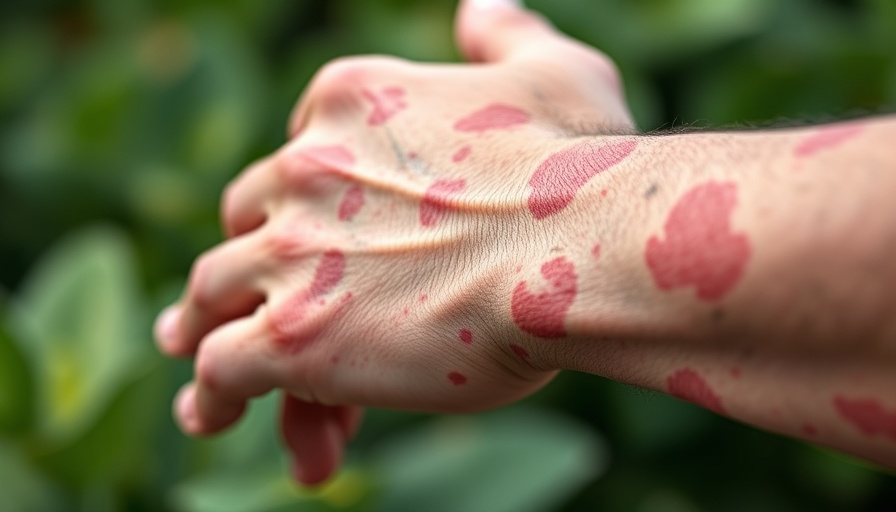
Revolutionary Breakthrough: Roflumilast Cream for Young Patients
In a significant leap for pediatric dermatology, Roflumilast cream 0.3% has been identified as a safe and effective treatment for plaque psoriasis in children aged 2 to 11 years. This new topical therapy targets the inflammatory pathways connected to psoriasis, promising relief for young patients suffering from this chronic skin condition. Plaque psoriasis can often lead to physical discomfort and emotional distress, making it crucial to find effective treatments that are well-tolerated by young skin.
Understanding Psoriasis in Children: A Growing Concern
Psoriasis, typically associated with adults, has shown increased prevalence in younger populations. The effects of this chronic disease can be debilitating, leading not only to painful skin lesions but also impacting children's self-esteem and social interactions. Traditional treatments may include systemic medications that carry heavier side effects, hence the excitement surrounding the Roflumilast cream, which offers a more localized and safer approach.
How Roflumilast Works: Mechanism of Action
The active ingredient, Roflumilast, is a phosphodiesterase-4 (PDE4) inhibitor. By inhibiting PDE4, it reduces the production of inflammatory cytokines that exacerbate psoriasis symptoms. This targeted mechanism translates to a reduction in the inflammation and keratinocyte overproliferation characteristic of psoriasis. Unlike other systemic treatments that might expose children to significant risk, Roflumilast can be directly applied to the affected areas, minimizing systemic absorption and potential side effects.
Clinical Study Insights: Efficacy and Safety Profile
A recent clinical study highlighted the efficacy of Roflumilast cream in pediatric patients. Nearly 60% of participants showed significant improvement in plaque severity scores after 8 weeks of treatment. Additionally, the safety profile was favorable, with only mild and localized side effects reported. Given these findings, dermatologists might consider this therapy as a first-line option for managing plaque psoriasis in children.
Environmental Considerations: A Sustainable Approach
The development of Roflumilast cream not only heralds a new therapeutic option for young patients but also aligns with eco-conscious dermatological practices. By utilizing a topical formulation, reliance on systemic treatments—often linked to broader environmental impacts—is reduced. This aligns with a growing trend in the pharmaceutical industry focused on sustainable and safer therapeutic options.
Voices from the Medical Community: Diverse Perspectives
Several dermatologists and pediatric specialists agree that Roflumilast cream represents a promising addition to the therapeutic arsenal against plaque psoriasis. Dr. Sarah Rosen, a pediatric dermatologist, emphasizes the excitement amongst her peers: “This medication marks a significant advancement, especially considering the hypoallergenic nature of the cream, which limits irritation and fits pediatric needs.” A contrasting voice, however, calls for a more cautious approach, advocating for long-term studies to ascertain the lasting effects of PDE4 inhibition therapy in children.
Future Predictions: The Evolving Landscape of Psoriasis Treatment
Looking ahead, the introduction of Roflumilast cream could reshape the treatment landscape for pediatric psoriasis. As more pediatric dermatology studies emerge, this could pave the way for new classes of targeted therapies. Future research will likely focus on combination therapies that could enhance the efficacy and convenience of psoriasis management. This innovation promises an encouraging horizon for health professionals aiming to improve quality of life for children with chronic skin conditions.
Conclusion: A Call to Arms for Pediatric Psoriasis Awareness
In light of the promising results associated with Roflumilast 0.3% cream, it is essential for parents, caregivers, and healthcare providers to foster an environment where conditions like pediatric psoriasis are openly discussed and effectively managed. This breakthrough offers hope, yet continued advocacy and education surrounding psoriasis is paramount to ensure young patients receive timely and effective treatments.
 Add Row
Add Row  Add
Add 




Write A Comment